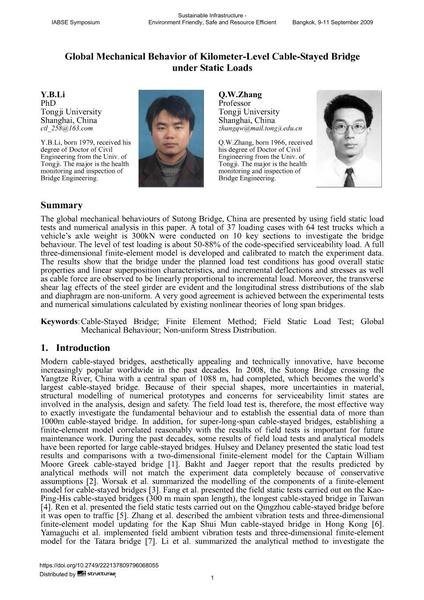Global Mechanical Behavior of Kilometer-Level Cable-Stayed Bridge under Static Loads

|
|
|||||||||||
Détails bibliographiques
| Auteur(s): |
Y. B. Li
Q. W. Zhang |
||||
|---|---|---|---|---|---|
| Médium: | papier de conférence | ||||
| Langue(s): | anglais | ||||
| Conférence: | IABSE Symposium: Sustainable Infrastructure - Environment Friendly, Safe and Resource Efficient, Bangkok, Thailand, 9-11 September 2009 | ||||
| Publié dans: | IABSE Symposium Bangkok 2009 | ||||
|
|||||
| Page(s): | 72-79 | ||||
| Nombre total de pages (du PDF): | 8 | ||||
| Année: | 2009 | ||||
| DOI: | 10.2749/222137809796068055 | ||||
| Abstrait: |
The global mechanical behaviours of Sutong Bridge, China are presented by using field static load tests and numerical analysis in this paper. A total of 37 loading cases with 64 test trucks which a vehicle’s axle weight is 300kN were conducted on 10 key sections to investigate the bridge behaviour. The level of test loading is about 50-88% of the code-specified serviceability load. A full three-dimensional finite-element model is developed and calibrated to match the experiment data. The results show that the bridge under the planned load test conditions has good overall static properties and linear superposition characteristics, and incremental deflections and stresses as well as cable force are observed to be linearly proportional to incremental load. Moreover, the transverse shear lag effects of the steel girder are evident and the longitudinal stress distributions of the slab and diaphragm are non-uniform. A very good agreement is achieved between the experimental tests and numerical simulations calculated by existing nonlinear theories of long span bridges. |
||||
| Mots-clé: |
Pont à haubans
|
||||
